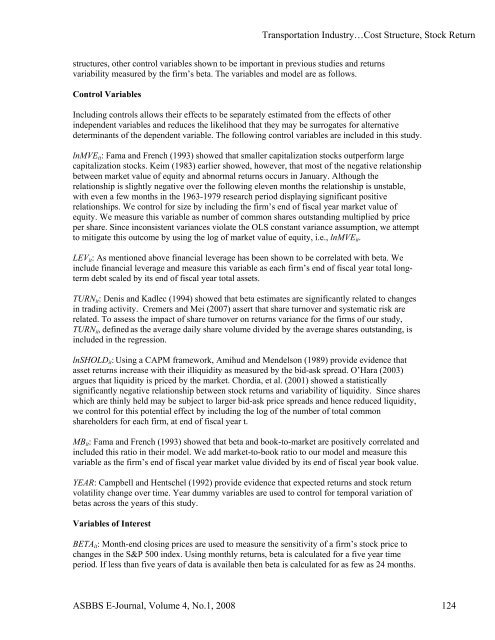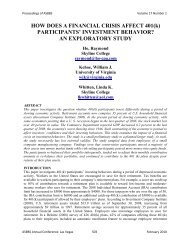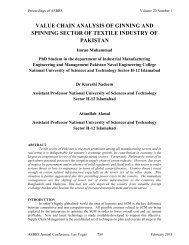stock repurchase announcements: a test of market ... - Asbbs.org
stock repurchase announcements: a test of market ... - Asbbs.org
stock repurchase announcements: a test of market ... - Asbbs.org
Create successful ePaper yourself
Turn your PDF publications into a flip-book with our unique Google optimized e-Paper software.
Transportation Industry…Cost Structure, Stock Return<br />
structures, other control variables shown to be important in previous studies and returns<br />
variability measured by the firm’s beta. The variables and model are as follows.<br />
Control Variables<br />
Including controls allows their effects to be separately estimated from the effects <strong>of</strong> other<br />
independent variables and reduces the likelihood that they may be surrogates for alternative<br />
determinants <strong>of</strong> the dependent variable. The following control variables are included in this study.<br />
lnMVEit: Fama and French (1993) showed that smaller capitalization <strong>stock</strong>s outperform large<br />
capitalization <strong>stock</strong>s. Keim (1983) earlier showed, however, that most <strong>of</strong> the negative relationship<br />
between <strong>market</strong> value <strong>of</strong> equity and abnormal returns occurs in January. Although the<br />
relationship is slightly negative over the following eleven months the relationship is unstable,<br />
with even a few months in the 1963-1979 research period displaying significant positive<br />
relationships. We control for size by including the firm’s end <strong>of</strong> fiscal year <strong>market</strong> value <strong>of</strong><br />
equity. We measure this variable as number <strong>of</strong> common shares outstanding multiplied by price<br />
per share. Since inconsistent variances violate the OLS constant variance assumption, we attempt<br />
to mitigate this outcome by using the log <strong>of</strong> <strong>market</strong> value <strong>of</strong> equity, i.e., lnMVEit.<br />
LEVit: As mentioned above financial leverage has been shown to be correlated with beta. We<br />
include financial leverage and measure this variable as each firm’s end <strong>of</strong> fiscal year total longterm<br />
debt scaled by its end <strong>of</strong> fiscal year total assets.<br />
TURNit: Denis and Kadlec (1994) showed that beta estimates are significantly related to changes<br />
in trading activity. Cremers and Mei (2007) assert that share turnover and systematic risk are<br />
related. To assess the impact <strong>of</strong> share turnover on returns variance for the firms <strong>of</strong> our study,<br />
TURNit, defined as the average daily share volume divided by the average shares outstanding, is<br />
included in the regression.<br />
lnSHOLDit: Using a CAPM framework, Amihud and Mendelson (1989) provide evidence that<br />
asset returns increase with their illiquidity as measured by the bid-ask spread. O’Hara (2003)<br />
argues that liquidity is priced by the <strong>market</strong>. Chordia, et al. (2001) showed a statistically<br />
significantly negative relationship between <strong>stock</strong> returns and variability <strong>of</strong> liquidity. Since shares<br />
which are thinly held may be subject to larger bid-ask price spreads and hence reduced liquidity,<br />
we control for this potential effect by including the log <strong>of</strong> the number <strong>of</strong> total common<br />
shareholders for each firm, at end <strong>of</strong> fiscal year t.<br />
MBit: Fama and French (1993) showed that beta and book-to-<strong>market</strong> are positively correlated and<br />
included this ratio in their model. We add <strong>market</strong>-to-book ratio to our model and measure this<br />
variable as the firm’s end <strong>of</strong> fiscal year <strong>market</strong> value divided by its end <strong>of</strong> fiscal year book value.<br />
YEAR: Campbell and Hentschel (1992) provide evidence that expected returns and <strong>stock</strong> return<br />
volatility change over time. Year dummy variables are used to control for temporal variation <strong>of</strong><br />
betas across the years <strong>of</strong> this study.<br />
Variables <strong>of</strong> Interest<br />
BETAit: Month-end closing prices are used to measure the sensitivity <strong>of</strong> a firm’s <strong>stock</strong> price to<br />
changes in the S&P 500 index. Using monthly returns, beta is calculated for a five year time<br />
period. If less than five years <strong>of</strong> data is available then beta is calculated for as few as 24 months.<br />
ASBBS E-Journal, Volume 4, No.1, 2008 124

















